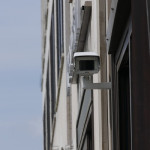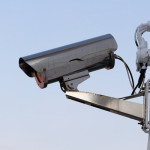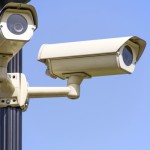Security Camera Image Sensors: CCD Vs. CMOS
Choosing the best security camera system can be based on many factors. When it comes to the individual security cameras, the quality of images and video captured is largely dependent on the image sensor.
The image sensor (also known as the “eye”) determines the imaging capability and performance of your security camera. Their duty is to convert an optical image into an electrical signal, and is either a charge-coupled device (CCD) or a complementary metal-oxide semiconductor (CMOS) active pixel sensor.
To better understand which type of image sensor will work best for your security camera needs, we will take a look at the differences between CCD and CMOS.
What Is A CCD Image Sensor?
CCD’s receive light and convert it to electrons, then carry the electrons to a specific area across the chip to be processed. The conversion of analog light signals into digital pixels takes place in the chip without distortion. The special manufacturing process of CCD’s produces high-quality sensors in terms of fidelity and light sensitivity.
What Is A CMOS Image Sensor?
The CMOS sensor came from the MOS active pixel image sensor which emerged in the 1960s. Since then, its design and function has greatly improved, containing integrated circuitry and arrays of pixel sensors. Unlike the CCD, CMOS sensors process the elections at the same place that it receives the light, thus making it faster and smaller. The CMOS is able to do so because it has multiple transistors at each pixel, offering flexibility because each pixel is treated individually.
CCD vs. CMOS
Now that we have covered the basics, we can compare the strengths and weaknesses of CCD and CMOS cameras.
- CCD cameras provide high-quality images with low noise (grain), whereas CMOS cameras are more susceptible to noise. CMOS cameras often need more light to create a low noise image at proper exposure.
- CCD cameras possess better light sensitivity than CMOS cameras, since the CMOS sensors have more transistors next to each pixel, which may interfere with the amount of light that reaches the photodiode (where the picture is processed).
- CMOS sensors consume less power since the processes are confined to a smaller area. CCD sensors consume as much as 100 times more than CMOS.
- CMOS chips require a simple and traditional manufacturing process (same as creating microchips) making them easier to produce and much more affordable than CCD. As mentioned, CCD sensors require a special manufacturing process which makes them more expensive.
Common Applications
In these common applications, one camera outshines the other.
- Because of their superior light sensitivity and large effective imaging area, CCD cameras are better suited for low light conditions than CMOS cameras.
- Since the CMOS image sensor is compact, CMOS cameras are better for hidden or covert surveillance.
- Choose CMOS cameras for high-frame speed video shooting since the CMOS image sensor has a very fast processing speed (thanks to its ability to directly convert photoelectric signal to digital signal).
Which type of security cameras do you prefer? Share with us on Facebook, Google+, Twitter, LinkedIn, and Pinterest.
To shop our stock of security cameras and surveillance equipment, including CMOS cameras and CCD cameras, visit SecurityCamExpert.com. If you are located in Southern California and would like to schedule a site survey or request a free quote, please call 888-203-6294.
Wired Security Cameras Vs. Wireless Security Cameras
Security cameras offer great benefits for various settings. From protecting your business or property to keeping an eye on nursing homes or daycare centers, surveillance camera systems can be incredibly helpful.
The extensive surveillance market is like a double-edged sword. While there is likely a security solution for nearly every need, sorting through the options to find the best security solution for you can be seemingly endless. However, with the proper approach and assistance, you can find a suitable surveillance system in a timely manner.
When shopping for security camera systems, it is best to evaluate your needs and research which solutions may better suit you. For example, choosing between wired or wireless security cameras can be determined by weighing their advantages and disadvantages, while understanding how these can play into your specific requirements.
To help you choose which is better for you, here are some basic pros and cons of both wired and wireless security cameras.
Wired Security Cameras
Pros
- Video is transmitted straight to your recorder with no interference from other wireless devices.
- A wide variety of camera styles are available.
- Wired cameras make it impossible for the signal to be jammed.
- IP-based wired cameras can provide video resolutions at High Definition and beyond, transmitting large amounts of data over CAT5 cabling.
Cons
- Installation involves wiring (and likely conduit), making it a lengthier and more complicated process.
- Changing the location of your cameras requires rewiring, thus providing less flexibility.
Wireless Security Cameras
Pros
- The absence of wiring enables an easier installation process.
- More flexibility in terms of relocating cameras.
- Wireless cameras can connect to your existing Wi-Fi network.
Cons
- Depending on the range of your Wi-Fi network, connectivity issues may arise.
- Picture quality is not as good as wired cameras provide.
- Crowded frequency (due to the overlapping of other wireless networks or channels) can lead to dropped signals, interference, and lost video.
- Frequency issues make these generally less reliable than wired cameras.
- If cameras are used outdoors, signal may be lost during inclement weather.
Other things to consider include the structure of your property or building and the location of power sources. While some may prefer strictly wired solutions, and others choose wireless, it is possible to create a hybrid system, incorporating both wired and wireless cameras. It is best to consider different options before deciding on a security system.
Let us help you create the best security camera system. Browse our stock online at SecurityCamExpert.com or call 888-203-6294 to discuss your options. You can also connect with us on Facebook, Google+, Twitter, LinkedIn, and Pinterest.
Security Cameras: Types, Housing & Features
Shopping for security camera systems may seem like a one-size-fits-all deal, but, unfortunately, it is not. Because there are a plethora of security camera types and surveillance features to be considered, it will take some time to decide. Evaluate your security needs, do some research and weigh your options. To make it easier, we will break down the different types, housing, and common features of security cameras.
Types
The following are the advantages and disadvantages of common security camera types.
- Fixed – As the name suggests, fixed cameras are positioned to capture an image and are always pointing in the intended direction. Because these do no move, they are more reliable than PTZ cameras and can be optimized with different housing and features.
- PTZ Cameras– PTZ stands for Pan, Tilt, and Zoom, thus, these cameras can be remotely positioned (thanks to specially designed motors and gears). These cameras may be set to automatically patrol an area, but they seem to be most effective when manually controlled.
For zoom capabilities, 32X is fairly common, although some higher end cameras may have a greater zoom range. While a greater zoom range is helpful when covering a large area, it is not always necessary.
However, there are some downfalls. Because PTZ cameras can adjust its viewing range, there are chances that they may miss something. Also, zoom decreases the size of the area being covered, and the camera can only be facing one direction at a time.
- 360-Degree Cameras – Also known as virtual PTZ, the 360-degree camera utilizes several high resolution fixed cameras in a single housing (usually dome). The images are then stitched together and can be zoomed in on after recording (zoom capabilities depend on the cameras being used). Because this type of camera can face in all directions, it can be an effective forensic tool.
Unfortunately, these cameras are often oversold as a universal solution, despite the fact that very few rooms allow for an unobstructed view in all directions. In applications where this camera is necessary, it often does wonderfully. However, a standard fixed camera can be paired with a lens to give it a 120-degree to 140-degree view. Also, many rooms are better monitored with cameras in corners (which only require a 90-degree field of view).
Housing
Once you have chosen the camera type, housing will come into play.
- Outdoor – Because of changing environmental elements, outdoor camera housing will be more weather resistant and include heaters and blowers.
- Dome – These are designed to obscure the direction of the camera to outsiders. This is often the best deterrent, making it a high priority and often a default selection. Most people assume dome cameras cover the entire area, making a fixed dome camera covering a door entrance more effective.
- Bullet – These are named for their sleek, cylindrical shape, often times resembling a bullet. This housing clearly shows the direction of the lens and generally provides a better picture. The front of the housing is close to the camera lens, decreasing reflections and making it easier to maintain. These act as deterrents as well, but are not as effective as ambiguous housing.
- Discreet – These completely disguise the camera as something else, such as a smoke detector or motion sensor, or as nothing at all, with pinhole or flush mount lenses installed in a wall or ceiling. Because they are hidden, they are not designed to be deterrents. These are often favored by architects looking to achieve a certain aesthetic.
All types of housing can be made to be vandal resistant, which is a step up from weather resistant. These types of housings are most commonly dome shaped and are designed to withstand unfriendly environments while still providing a usable image.
Features
The selection of features for your security cameras will depend on the application and your individual needs.
- Resolution – Resolution is measured in megapixels (millions of pixels) and is a major factor in picture and video quality. The higher the resolution, the more space required to store the images and processing power to manipulate it.
To demonstrate the differences in resolution, an old analog camera is about ¼ megapixel, an HDTV screen is just over 2 megapixels, and the highest resolution projected image in movie theaters (4K) is 8.8 megapixels.
While higher resolution cameras may be appealing, these do not respond as well as lower resolution cameras in low light situations. Thus, it is possible to buy more resolution than you need, unnecessarily increasing storage costs while decreasing performance.
- Low Light – Cameras with day/night capabilities are able to automatically adjust modes in various lighting situations. With advanced technologies, these cameras are able to produce usable images in near total darkness.
There are also cameras with infrared illuminators, which provide their own light source to obtain better images in low light settings. As mentioned, in order to improve low light performance, you will need to sacrifice some resolution.
- Lens Features – Varifocal lenses allow the installer to manually adjust the image magnification when installing the camera. However, many fixed cameras now come with remote zoom and focus (allowing the user to adjust the camera without physically going to the camera site), as well as auto-focus.
- Advanced Options – Other options to consider include wireless signal transition, ultra-high resolution, thermal imaging, explosion proof housings and more.
No matter what the application, there’s likely a perfect security solution thanks to the comprehensive options available. And while the selection process may seem overwhelming, we are here to help. Feel free to browse our CCTV surveillance systems online at SecurityCamExpert.com or call 888-203-6294 to speak with a representative.
You can also connect with us on Facebook, Google+, Twitter, LinkedIn and Pinterest!
Transitioning From Analog Security Cameras To IP Surveillance
Upgrading your analog security cameras to IP security cameras has plenty of benefits, including improved image quality and advanced features. Most IP surveillance systems can make use of existing network infrastructure that is in good condition, decreasing costs for installation. Whether you are looking to upgrade because your analog system is reaching end-of-life for support or because your needs have changed, an IP surveillance system is a smart decision.
Now, the actual task of transitioning from analog to IP security cameras should not be taken lightly. You want to be sure that you take all things into consideration to ensure that you choose the right IP video surveillance system and that it performs sufficiently. Here are a few aspects you should not overlook:
Goals & Challenges
If you are looking to achieve ROI, you must fully understand how your IP security system will be used. Operational goals and potential challenges should be determined beforehand. Think about what types of cameras and how much resolution you need, as well as how long the footage needs to be stored and which areas need coverage. Proper planning is crucial to the success of your security system.
Budgets
No one wants to pay an arm and a leg for a mediocre surveillance system. If done correctly, you don’t need to. By defining a security budget, you can find the right cameras and video management software (VMS) to fulfill your needs and achieve your goals.
Time
As much as a quick transition sounds ideal, it is not always feasible. Understand that a proper transition will take some time, and it may be in your best interest to plan a phased migration. This will help to accommodate budget availability and operational disruptions. Prioritize which area needs immediate attention and begin there.
Storage
Going from analog to IP improves video quality, but also requires more storage. Advanced VMS can help to effectively optimize your network resources and bandwidth consumption, thus decreasing networking and storage costs over time.
Staffing
A new IP video system may need additional staffing, so you should think about this and how you will train the new and existing staff. This will impact both overall costs and ROI of your system, and may affect cameras and software selection. For example, casinos require live monitoring around the clock while parking lot surveillance may use video analytics to alert security personnel of incidents or events that need attention.
Integration
Numerous third-party integrations can help to increase the efficiency of your system as well as manage costs. While most current systems have an IP-based interface for integration, leading suppliers also have a wide range of integrations which are tested and ready to apply. These can offer functionality, automation, and other enhancements to solve project needs.
Cybersecurity
Cybersecurity is of utmost importance, especially these days. If not addressed properly, going from analog to IP opens up your system, and any indirectly connected networks, to endless vulnerabilities. Be sure to discuss your specific network safeguards, policies, and strategies with your installer. Also, enlist a new IP security system that provides the appropriate cybersecurity architecture, software, devices, and policies.
Licensing
Pay attention to licensing requirements and Software Upgrade Plans (SUPs) or Service Level Agreements (SLAs) that come with most VMS systems. These cover everything from higher tiers of support to future upgrades. For example, third-party cameras may require a license for each IP address, and these licensing requirements can add additional costs.
Environmental Conditions
These include extreme heat or cold, humidity, corrosion, and high dust levels, along with ambient light levels, existing power sources, and network infrastructure. All of these can impact which security cameras and VMS equipment are necessary for you.
Redundancy
Because your security system should be operational and accessible at all times, it is important plan provisions for redundancy and back up for primary resources in case they fail. For most systems, simple RAID-5 or -6 redundancy in storage is sufficient. However, you should also consider budgeting for “failover” recorders and other server hardware, and have spare cameras on hand in case of failure.
It is only a matter of time until IP surveillance is the norm and analog security cameras are a thing of the past. But when the day comes, it is ever important to understand your security needs and what you expect from your IP surveillance system. Even a small mistake or misstep along the way can compromise your system.
Have you upgraded to an IP security camera system? Share your stories with us on Facebook, Google+, Twitter, LinkedIn and Pinterest. You can shop our selection online at SecurityCamExpert.com or call 888-203-6294 to inquire about our products, installation services, or request a free quote!



